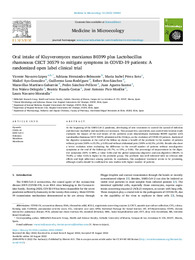Please use this identifier to cite or link to this item:
https://hdl.handle.net/11000/36545Full metadata record
| DC Field | Value | Language |
|---|---|---|
| dc.contributor.author | navarro-lopez, vicente | - |
| dc.contributor.author | Hernández Belmonte, Adriana | - |
| dc.contributor.author | Pérez Soto, Maria Isabel | - |
| dc.contributor.author | Ayo González , Maikel | - |
| dc.contributor.author | Losa Rodríguez, Guillermo | - |
| dc.contributor.author | Ros-Sánchez, Esther | - |
| dc.contributor.author | Martínez Gabarrón, Maravillas | - |
| dc.contributor.author | Sánchez-Pellicer, Pedro | - |
| dc.contributor.author | Aguera Santos, Juan | - |
| dc.contributor.author | Núñez-Delegido, Eva | - |
| dc.contributor.author | Ruzafa-Costas, Beatriz | - |
| dc.contributor.author | Pico-Monllor, JOSE ANTONIO | - |
| dc.contributor.author | Navarro-Moratalla, Laura | - |
| dc.contributor.other | Departamentos de la UMH::Farmacología, Pediatría y Química Orgánica | es_ES |
| dc.date.accessioned | 2025-05-02T09:14:26Z | - |
| dc.date.available | 2025-05-02T09:14:26Z | - |
| dc.date.created | 2022-08 | - |
| dc.identifier.citation | Medicine in Microecology 2022 Dec:14:100061 | es_ES |
| dc.identifier.issn | 2590-0978 | - |
| dc.identifier.uri | https://hdl.handle.net/11000/36545 | - |
| dc.description.abstract | At the beginning of the SARS-CoV-2 pandemic, developing of new treatments to control the spread of infection and decrease morbidity and mortality are necessary. This prospective, open-label, case-control intervention study evaluates the impact of the oral intake of the probiotic yeast Kluyveromyces marxianus B0399 together with Lactobacillus rhamnosus CECT 30579, administered for 30 days, on the evolution of COVID-19 patients. Analysis of the digestive symptoms at the end of the follow up shows a benefit of the probiotic in the number of patients without pyrosis (100% vs 33.3%; p 0.05) and without abdominal pain (100% vs 62.5%; p 0.04). Results also show a better evolution when evaluating the difference in the overall number of patients without non-digestive symptoms at the end of the follow-up (41.7%, vs 13%; p 0.06). The percentage of improvement in the digestive symptoms (65% vs 88%; p value 0.06) and the global symptoms (digestive and non-digestive) (88.6% vs 70.8%; p value 0.03) is higher in the probiotic group. The probiotic was well tolerated with no relevant side effects and high adherence among patients. In conclusion, this coadjutant treatment seems to be promising, although results should be confirmed in new studies with higher number of patients. | es_ES |
| dc.format | application/pdf | es_ES |
| dc.format.extent | 6 | es_ES |
| dc.language.iso | eng | es_ES |
| dc.publisher | Elsevier | es_ES |
| dc.rights | info:eu-repo/semantics/openAccess | es_ES |
| dc.rights | Attribution-NonCommercial-NoDerivatives 4.0 Internacional | * |
| dc.rights.uri | http://creativecommons.org/licenses/by-nc-nd/4.0/ | * |
| dc.subject | COVID-19 | es_ES |
| dc.subject | SARS-CoV-2 | es_ES |
| dc.subject | Probiotics | es_ES |
| dc.subject | Microbiota | es_ES |
| dc.subject | Microbiome | es_ES |
| dc.title | Oral intake of Kluyveromyces marxianus B0399 plus Lactobacillus rhamnosus CECT 30579 to mitigate symptoms in COVID-19 patients: A randomized open label clinical trial | es_ES |
| dc.type | info:eu-repo/semantics/article | es_ES |
| dc.relation.publisherversion | https://doi.org/10.1016/j.medmic.2022.100061 | es_ES |

View/Open:
Oral intake of Kluyveromyces marxianus B0399 plus Lactobacillus.pdf
348,83 kB
Adobe PDF
Share:
.png)
